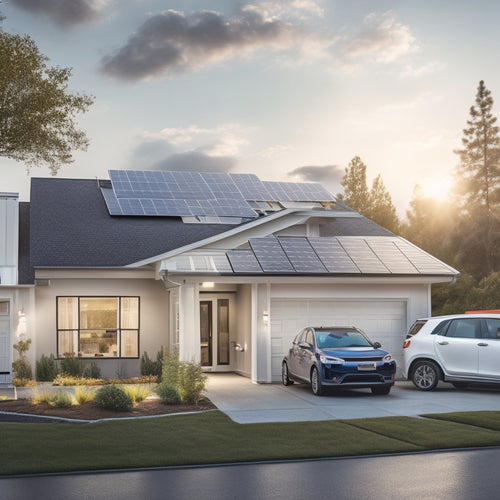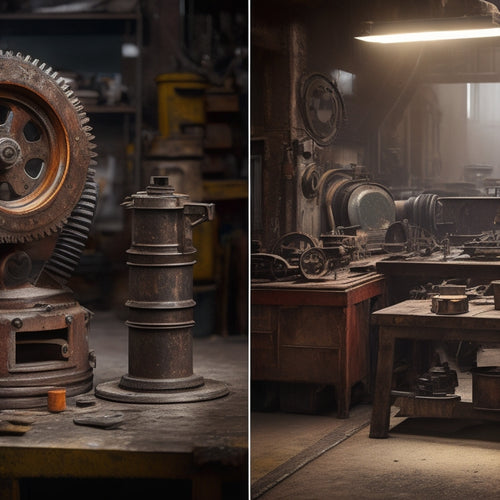
Set Up Your Solar System in 3 Easy Steps
Share
You can set up your solar system in just three easy steps. First, assess your energy needs by analyzing past utility bills to determine your average daily consumption and peak demand, ensuring your system is the right size for your home. Next, choose your solar equipment, including panel type, inverter option, and battery storage, considering factors like cost, efficiency, and performance. Finally, install and connect your system, mounting panels securely, converting DC to AC power, and linking to the grid, and you'll be on your way to utilizing the sun's energy - and there's more to investigate to optimize your system's potential.
Key Takeaways
- Determine your energy needs by analyzing past utility bills to ensure your solar system is the right size.
- Choose the right equipment, including solar panels, inverters, and battery storage, for optimal energy production and cost savings.
- Ensure a secure and efficient installation by mounting solar panels correctly and connecting them to the inverter and grid tie.
- Monitor your system's performance in real-time to track energy production and consumption and identify areas for improvement.
- Take advantage of government financial incentives, such as tax credits, to offset the cost of your solar system investment.
Assess Your Energy Needs
Your home's energy appetite is a vital factor in determining the size and complexity of your solar system. To accurately evaluate your energy needs, you'll need to calculate your energy consumption. This involves analyzing your past utility bills to identify patterns and trends in your energy usage.
You'll want to note the average daily consumption in kilowatt-hours (kWh) and the peak demand in kilowatts (kW). Understanding your energy consumption is essential in designing a solar system that meets your needs. A system that's too small won't cover your energy needs, while one that's too large will be a waste of resources.
Fortunately, the government offers financial incentives, such as tax credits, to encourage homeowners to invest in solar energy. By accurately evaluating your energy needs, you can maximize these incentives and guarantee a strong return on investment.
Choose Your Solar Equipment
Several key components make up a solar system, and selecting the right equipment is crucial for its performance and efficiency. You'll need to choose the right solar panel types, inverter options, and battery storage solutions to meet your energy needs.
Taking into account the following components will help you make an informed decision:
-
Solar Panels: Monocrystalline, polycrystalline, or thin-film solar panels - each type has its pros and cons, and you'll need to take into account factors like energy output, durability, and cost.
-
Inverter Options: String inverters, microinverters, or power optimizers - the choice depends on your system's size, complexity, and energy requirements.
-
Battery Storage: Lead-acid, lithium-ion, or saltwater batteries - you'll need to take into account factors like capacity, depth of discharge, and maintenance requirements.
- System Costs and Maintenance: Calculate installation costs, take into account energy efficiency, and plan for regular maintenance to guarantee your system runs smoothly and efficiently.
Install and Connect System
With your solar equipment chosen, it's time to bring your system to life. Now, you'll focus on the installation process, which involves connecting all system components.
Start by mounting the solar panels on your roof, confirming they're securely fastened and angled for maximum energy absorption. Next, connect the panels to the inverter, which converts DC power into usable AC power.
Connect the inverter to the grid tie, allowing your system to synchronize with the electrical grid. Then, link the grid tie to your electrical panel, enabling the flow of electricity into your home.
Finally, connect the monitoring system to track your energy production and consumption in real-time.
Throughout the installation process, verify all connections are secure and meet local electrical codes. It's crucial to follow the manufacturer's instructions and consider hiring a professional if you're not comfortable with electrical work.
With your system components connected, you're ready to utilize the power of the sun and start generating clean energy.
Frequently Asked Questions
Can I Add More Panels to My System Later?
You're thinking ahead, planting a seed for future solar growth! Yes, you can add more panels later, but make sure they're compatible with your existing system for seamless solar expansion.
Will My System Work During a Power Outage?
During a power outage, you'll stay energized if your system's equipped with off-grid capabilities and battery storage, allowing you to harvest and store energy, ensuring your lights stay on and your appliances keep running when the grid goes down.
How Long Does a Typical Solar Panel Last?
You'll be pleased to know that a typical solar panel lasts around 25-30 years, with a gradual efficiency degradation of about 0.5-1% per year, ensuring a consistent energy supply for your power needs.
Can I Install Solar Panels on a Metal Roof?
You're building a solar-powered fortress, and metal roofs beckon! Good news: metal roofs offer advantages like durability and water-tightness, but consider installation subtleties like roof pitch, material compatibility, and structural integrity before capturing the sun's energy.
Do Solar Panels Require Regular Maintenance?
You'll be happy to know that solar panels require minimal maintenance; however, you'll want to perform routine solar panel care, such as cleaning and inspecting, to guarantee ideal energy production - we'll share some important maintenance tips to keep your system running smoothly.
Related Posts
-

What Electric Vehicle Owners Need for Home Energy
As an electric vehicle owner, you need to optimize your home energy system to guarantee efficient, sustainable, and c...
-

Why Higher Upfront Costs Are Worth It
You pay a premium for high-quality, energy-efficient products, but they're worth it. With durability testing ensuring...
-

What Makes a Road Bike-Friendly by Design?
As you plan and design roads, incorporating features like dedicated bike lanes, smooth surfaces, and traffic calming ...


